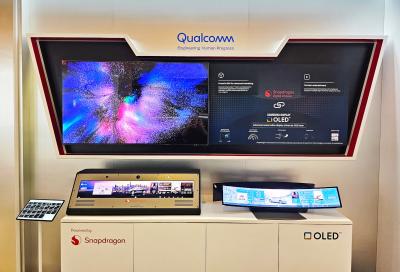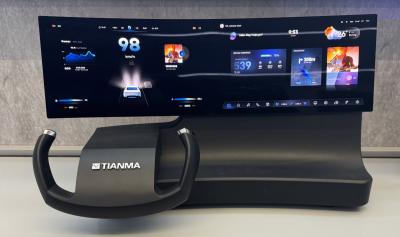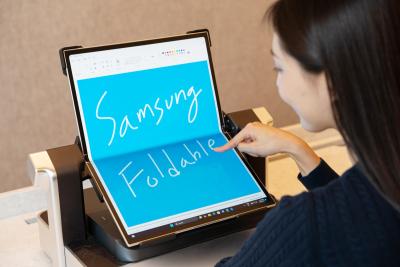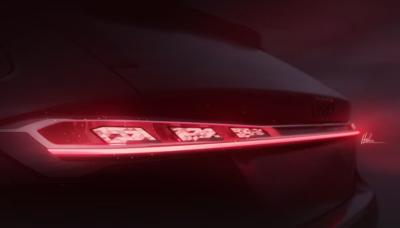Automotive OLEDs: introduction and industry news
OLED is a light-emitting technology used to create thin, efficient and flexible displays and lighting panels. OLEDs are useful in many applications, such as TVs, smartphones, wearables, laptops - and also automotive displays and lighting solutions.

Where can you OLEDs in cars?
There are several possible (and existing!) applications for OLED displays and lighting systems in cars:
- Dashboard displays (instrument clusters, navigation, media, HVAC...)
- Heads Up Displays (HUDs)
- Internal lighting
- External lighting (tail lights, turn indicators)
- Digital rear-view internal mirrors
- And more application we cannot think about today!
OLED displays for cars today
Several car models already use OLED displays today. Simple PMOLED displays have been adopted by automotive makers for many years, for example the Lexus 2010 RX for example has a white OLED display, supplementing the main 8" display.
Starting in 2021, automotive makers started to also adopt AMOLED displays in premium cars. The 2021 Mercedes S-Class for example comes standard with a 12.8-inch OLED, and the 2021 Cadillac Escalade sports a large 38-inch LGD P-OLED display (made from several displays). More recent examples include the 2024 Genesis GV70 and the Nio ET9.

We expect this trend to continue, as OLED makers such as LGD, SDC, BOE and others accelerate automotive AMOLED development.
OLED lighting in cars
The automotive market is one of the most interesting markets for OLED lighting, and one of the only markets in which OLED lighting finds early success. In 2016 Audi unveiled the 2016 TT RS, which sports optional OLED taillights - the first commercial car to sport the new lighting technology. Since then several models from Audi, BMW, Hongqi, Mercedes and others have adopted OLED lighting panels.

Hyundai Mobis aims to commercially launch a 18-inch rollable automotive display by 2028
According to reports from Korea, Hyundai Mobis has plans to launch a 18-inch rollable automotive display, ans has seemingly already signed up both General Motors, Hyundai Motors and Kia to adopt this display into four models, that will launch in 2028.
Hyundai Mobis hasn't yet selected the supplier of its rollable display, and it is talking to both Samsung Display and LG display. Both companies haven't yet commercialized automotive-grade rollable displays, and the development contract will have to be signed within a few months if the companies hope to have a commercial launch in 2028.
Samsung Display to supply automotive AMOLEDs for Qualcomm's demonstration cockpits
Samsung Display announced that it has signed a Memorandum of Understanding (MoU) with Qualcomm Technologies, for a potential supply of AMOLED display for Qualcomm Technologies’ Snapdragon Cockpit Experience Development Platform (CEDP) to provide next generation in-cabin experiences.
Qualcomm's Snapdragon CEDP is designed to deliver advanced functionality to help automakers build highly immersive, intuitive and sophisticated in-vehicle experiences. SDC will provide a 34-inch 6K (6,008 x 934) wide OLED display for the CEDP demo kit.
Tianma and Corning show a dual-screen multi-curved color-matched automotive OLED display
At CES 2025, Tianma unveiled a new display prototype that it has developed in collaboration with Corning. This is an automotive OLED display that is made from two 13-inch AMOLED panels. The company says the new display offers "unparalleled visual clarity in automotive applications".
The new OLED display features a unique multi-curvature design, with a left curvature radius of R800mm for optimal driver focus, a middle curvature radius of R1140mm, and a right curvature radius of R2160mm to accommodate the passenger. The system seamlessly bonds two color-matched 13" OLED displays to the multi-curve cover glass made possible with Corning ColdForm technology.
Samsung Display shows new OLED technologies at CES 2025
Samsung Display is set to show new OLED technologies at CES 2025, including new foldable display, rollable ones, automotive displays, next-gen QD-OLED panels and more.
So first up, Samsung will be showing a 18.1 foldable OLED display (which it says is the world's largest). This panel is suitable for IT devices - to enable devices that combine tablet, laptop and monitor devices into one. When folded, this display is 13.1" in size.
The Audi 2025 A5 and S5 cars to sport OLEDWorks' 2.0 digital lighting rearlights
OLEDWorks proudly announces that the Audi A5 and S5 vehicles are to incorporate its cutting-edge digital OLED 2.0 technology, powered by the Atala brand.
In the new A5 and S5, there will be 6 modules, each with about 60 red emitting OLED panels. The total number of panels is 364. The panels provide personalized lighting signatures and dynamic, adaptive communication on the road.
OLEDWorks officially launches its 2nd-Gen Atala automotive digital OLED lighting solution
Last year Audi unveiled its upcoming 2024 Q6 e-tron car, with the 2nd-generation OLEDWorks digital lighting solution. Now OLEDWorks formally launched its Atala digital OLED 2.0 technology, which is now available for automotive producers and Tier-1 suppliers.
By digital OLED technology, OLEDWorks means that these are taillights in which each segment (there could be 10 to 128 segments in each module) is controlled individually, making it into a simple display system. The company says that digital OLED 2.0 delivers unparalleled functionality and performance. The second generation solution offers more panel options and higher level of integration and features.
Samsung Display signs a strategic partnership with Dolby to improve its automotive OLED displays
Samsung Display announced today a strategic partnership with Dolby Laboratories, to offer SDC's automotive displays which are pre-tuned to deliver Dolby Vision to automotive makers.
Samsungs says that by implementing a new streamlined evaluation and implementation process it will be able to offer best-in-class imaging experiences for automotive displays.
UBI: Samsung's automotive OLED shipments rise, but sales of tablet OLED displays are soft
UBI Research says that Samsung Display's medium and large OLED panel shipments in Q3 2024 were the same as in the previous quarter. Shipments of tablet OLED devices were low, but this was offset by increased sales of automotive displays. Compared to 2023, total medium and large OLED panel shipments more than doubled, mainly due to increased sales of tablet panels to Apple, and increased laptop OLED shipments.
UBI estimates that SDC's tablet PC sales decreased by 38% compared to the previous quarter. Automotive OLED shipments rose from 100,000 units in Q1 2024 to around 500,000 in Q3.
UBI: Apple reduces its iPad AMOLED orders from Samsung and LG as demand for its tablets is low
UBI Research estimates that Apple suffers from poor demand for its iPad Pro devices, and the company has reduced its orders from LG Display and Samsung Display. We heard signs of that already back in August.
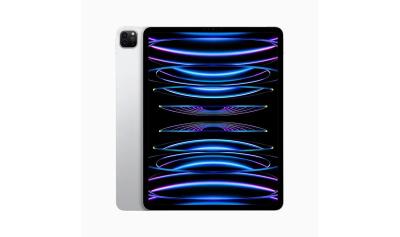
UBI estimates that LG Display's medium to large sized OLED panels shipments decreased 34% in Q3 2024, compared to the previous quarter. Samsung Display's tablet OLED panel sales dropped 38% in the quarter. Samsung however enjoyed higher sales of automotive OLEDs, which means that its entire medium-to-large sales were flat in the quarter.
Japan Display, Innolux and CarUX to bring eLEAP automotive displays to market
Japan Display announced a new strategic partnership with Taiwan-based Innolux and CarUX (Innolux's automotive display company) to bring eLEAP OLED displays to the automotive market.
The three companies did not disclose a lot of details, but it seems as in this partnership JDI will produce the eLEAP OLED displays while CarUX will market and sell these displays to its automotive customers. The first display that JDI will produce will be a 32" 1,000 nits 6460x880 (205 PPI) AMOLED display on an HMO (high-mobility oxide) backplane.
Pagination
- Page 1
- Next page

